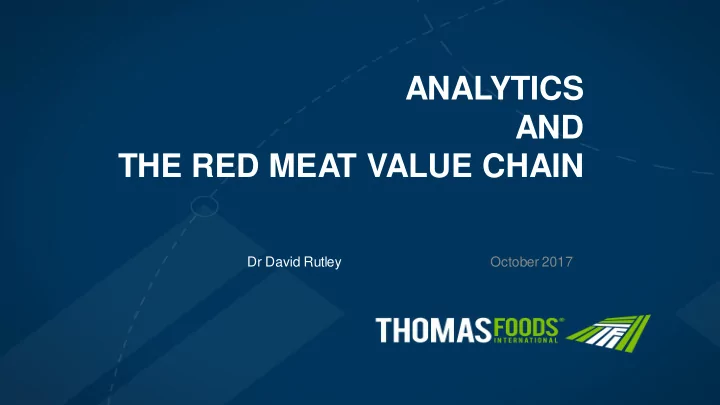

ANALYTICS AND THE RED MEAT VALUE CHAIN Dr David Rutley October 2017
Introduction • Red Meat Industry • Thomas Foods International • Production, Prices, Volume & Variation • Adoption of Analytics • SAS or Fools
David Rutley • Lamb Supply Chain Coordinator • 30 years Red Meat Industry production & research • Consumer Appeal, Retail, Food Service, Distribution, Processing, Finishing, Production, Genetics • Thomas Foods – Quantify and Connect the Supply Chain Signals from the Consumer to the Producer
Red Meat Industry • Unsophisticated traders • Buyers and sellers negotiate the spot price • Accountants check profit daily to monitor & control prices & production • Little to no prediction • Lots of use of Excel, so I report in Excel
Red Meat Industry • Largest Ag industry in Australia Including flow on effects • $23 Billion p.a. • Employs > 134,000 people • $8.7 Billion household income
Thomas Foods International • Australia’s largest family owned red meat processor • > $ 1.5 Billion p.a. • 3 Plants Murray Bridge, Lobethal, Tamworth • Domestic distributor, Holco • USA distributor, TFI USA
Thomas Foods International • ~25,000 sheep, lambs & goats & 1,100 cattle per day • ~3.5 Million lambs p.a. 200,000 cattle p.a. ~1.5 Million sheep p.a. • 15 - 20% of Australia’s sheep – largest processor
80% Lamb exported approx 8 - 10% global trade
Inside the Machine Last 3 years • ~10,000 different suppliers • 25 different types of beef cattle – Organic, Angus, grass fed, grain fed, short, long & very long fed … • New season’s lamb, lamb, hogget, mutton, goat – Organic, grass fed, grain fed …
Inside the Machine • 1 lamb 25 kg carcass 20 kg saleable ~1.3 cartons • 1 beef 280 kg carcass 200 kg saleable ~13 cartons Deconstructing a black box – Genotype by Environment = Variation CV HSCW = 15% 95% PL 70 to 130% • >3,200 products • 70+ countries
Product Sales – Murray Bridge 2014 Jul – 2016 Dec • >3,200 different Products, 285,000 tonnes, 14.9 M cartons, $1.6 B } Max Price $44.81/kg Min Price $0.67/kg Show SAS Table of Carton Weights 26% variance over 8 months
Supply Costs – Beef & Lamb – HIGHLY Volatile
Somewhat Complex • With this level of complexity and variation – How do we know we are going to make a profit? • Continual monitoring and controlling Little to no prediction • Trial and Error & Experience
Somewhat Complex How do we know we are going to make a profit? • Food is so important that it’s production MUST be viable over the long term. • TFI’s beef processing probably did not make a profit at any stage in 2016 and for at least ½ of 2017
The Future = Analytics • Profit = Income – Expense • Value = Profit – Risk • Risk = Chance of a Loss Stochastic Model MUST understand RISK & therefore VARIATION MUST develop Predictive Models
Beef – Predict Processing Yield • 1 Beef Carcass • > 50 possible pieces of meat • > 230 possible cuts of meat, bone, trim, fat or waste TFI Beef Yield Prediction Model based on • Hot Standard Carcass Weight • P8 Fat Depth • Muscle Score • Eye Muscle Area • Days in Chiller
Beef – Predict Processing Yield • Collecting data to relate sale price to cattle buying price • 25 beef programs, 10 important programs Price by Product Code from previous Table
Lamb Value Calculator – Predict Saleable Yield • 1 Lamb Carcass • > 36 possible pieces of meat • > 92 possible cuts of meat, bone, trim, fat or waste TFI Lamb Value Calculator based on • Hot Standard Carcass Weight • GR Fat Depth • Days in Chiller • Frequency of 4,536 different possible lamb carcasses
Lamb Value Calculator – Predict Saleable Yield Fatness Differences Not 0
Supplier Benchmarking – Rangers Valley Cattle Station Compare >2000 suppliers $750,000 per year • • • Value $20 per 400kg steer • Eliminated bottom 20% suppliers
Beef Eating Quality • > 17 traits • Have 1 minute to record 8 of these in the marshalling room. Lamb Eating Quality • 6 lambs/minute • Cannot measure pH or Intra Muscular Fat (marbling) this fast • Looking at hyperspectral imaging without cutting carcasses – 530 different wavelengths
Beef & Lamb Yield & Processing DEXA • Predict Lean Meat Yield • Drive robots for automated processing
David Rutley – Biologist & Applied Statistician Since 1984 • GLIMM, REG, Genstat, ASREML, S, SPSS, R & SAS (since 1994) I have found SAS to be the most capable of • handling Large & Complex data sets • Robust, Repeatable & Verifiable analyses
PROPHESIS Province of Deaf Mutes & Fools Provided we understand Confidence & Prediction Limits Good Prediction Better than Guessing I NVESTING vs G AMBLING K NOWLEDGE
THANK YOU……….
Recommend
More recommend